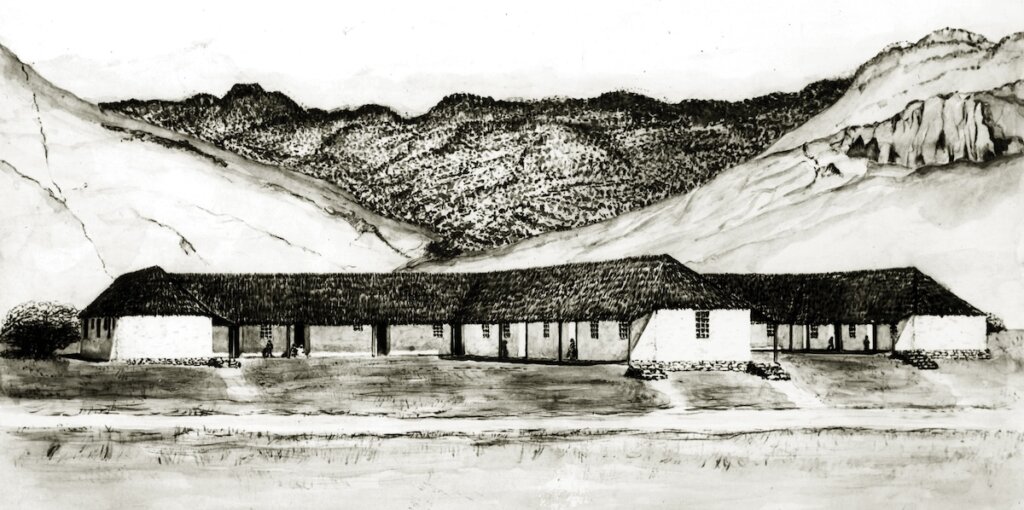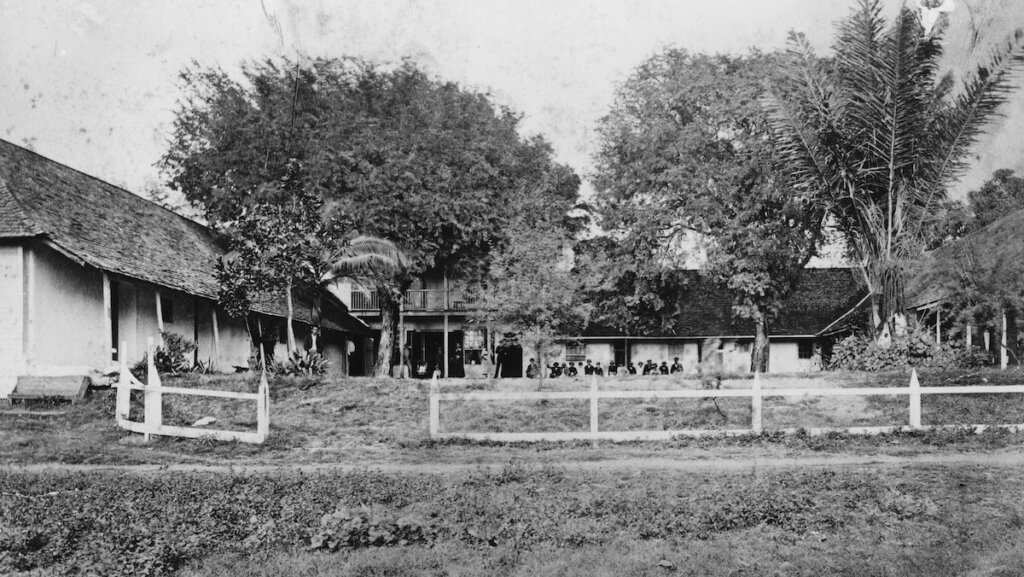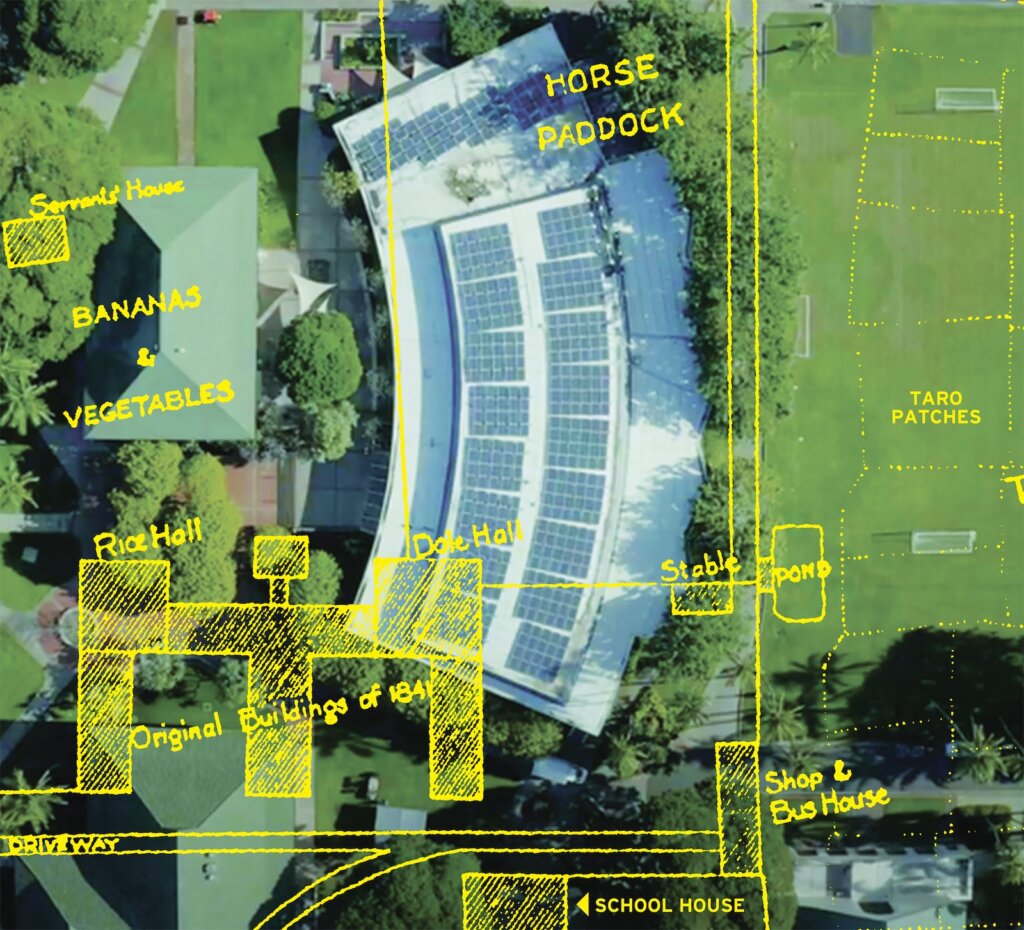

Unearthing Punahou’s Past
By Suzanne Sato ’67
The Mary Kawena Pukui Learning Commons will be a catalyst for change when it opens its doors in 2026 – much as was the historic E-building in 1841. As we prepare for our exciting future, the School is also learning about its past – thanks to the extensive archaeological and architectural review by Cultural Surveys Hawai‘i and Scientific Consultant Services Inc., which Punahou Director of Physical Plant Nate Armour coordinated.
In researching potential archaeological sites, a map from 1870 (highlighted in yellow on the map below) shows the footprint of the E-building relatively close to the makai side of the Pukui Learning Commons. Also depicted around the perimeter of the construction are a large horse paddock, banana trees and a vegetable garden, taro patches, a stable and the nearby School House (Old School Hall). Photographs of the period showed the pastures and open spaces of Mānoa Valley mauka of the campus.
Comprised of the original Rice and Dole Halls, the E-building included a 31 x 16-foot classroom, a sitting and prayer room, dining room and seven rooms for boarding students. The building was described as a purely native product. “Its timbers and rafters of wood had come from Mānoa Valley, the pili grass for its roof from Rocky Hill and the plaster and whitewash from the Kewalo reefs.” From 1841-1907, the E-building was the center of Punahou student life.
Uncovering fascinating insights about our architectural past was a considerable undertaking. David Shideler ’73 of Cultural Surveys Hawai‘i, prepared a thorough literary review which gathered historical background about the School and the property around the construction site. Based on overlays of the current building site and historic maps, 10 test areas within the construction site perimeter were identified for archaeological investigation. Small shards of wood and possible ceramic material were unearthed and sent for carbon-testing. Other discoveries were compacted clay and soil layers containing brick and mortar fragments from early building demolition and a possible portion of a horse stable wall. Foundation materials dating to the early 1900s were carefully reviewed by Glen Mason of Mason Architects.
Punahou proposed several strategies to illustrate the history of the site and educate present and future generations about predecessor buildings. These design elements include an outline of the location of the E-building incorporated into the flooring and paving design, and a site history will be created as part of the interior central stairway wall. Other materials found in the archaeological trenching will join early archival artifacts as teaching tools in exploration of Punahou’s deep connection to Hawai‘i’s past.
Caring for the integrity of our architectural legacy is an integral part of the design and construction in Hawai‘i’s permitting process, with the vigilance of the State of Hawai‘i Historic Preservation Division (SHPD) at the center of ensuring the integrity of new development statewide. Comprised of three branches – Architecture, Archaeology, and History & Culture – SHPD strives to preserve and protect Hawai‘i’s historic identity, believing that “looking back is an integral part of going forward” to ensure “that Hawai‘i’s treasured past is here for future generations to appreciate and learn from.” Both beautiful and historically significant, several Punahou buildings and its surrounding lava rock wall have been designated as part of the National Register of Historic Places, and in 1972, the Punahou campus was listed on the National Register.
An important component in the archaeological review for “growing and maintaining the School’s relationship with core community stakeholders relative to our cultural history,” calls for reaching out to Native Hawaiian community members and others with a historical connection to the School and the area to solicit feedback on the review results. Cultural Descendent and community leader Elizabeth-Ann Kahalaopuna Motoyama was invited to be part of this process.

Motoyama expressed it most eloquently in her written cultural consultation response: “The School continues to the present day to preserve and protect the springs from which its name was derived and to serve the purpose for which the School was established. Punahou has proven its commitment to endorse and value historic preservation.”

Learn more about the Learning Commons project at learningcommons.punahou.edu
